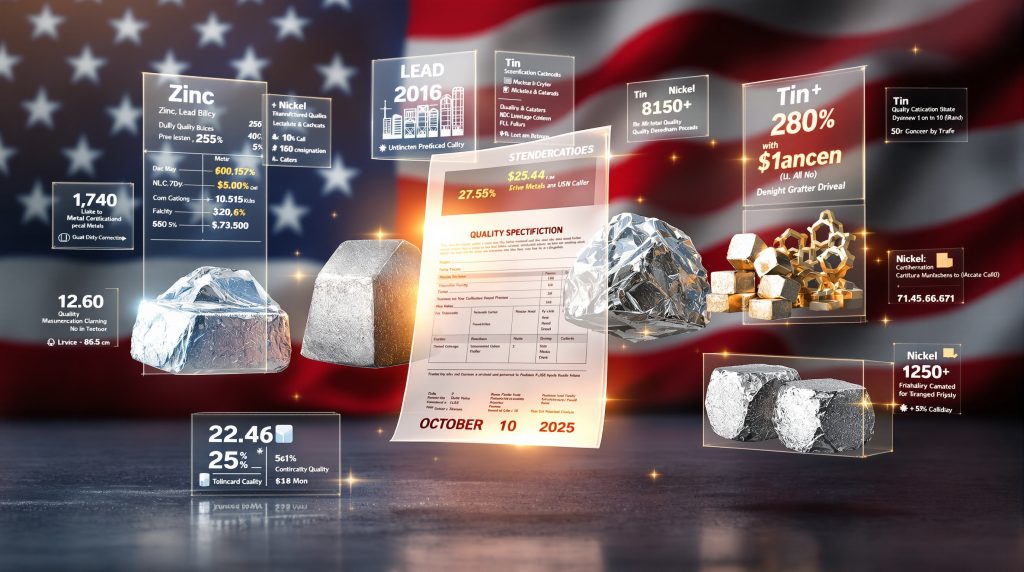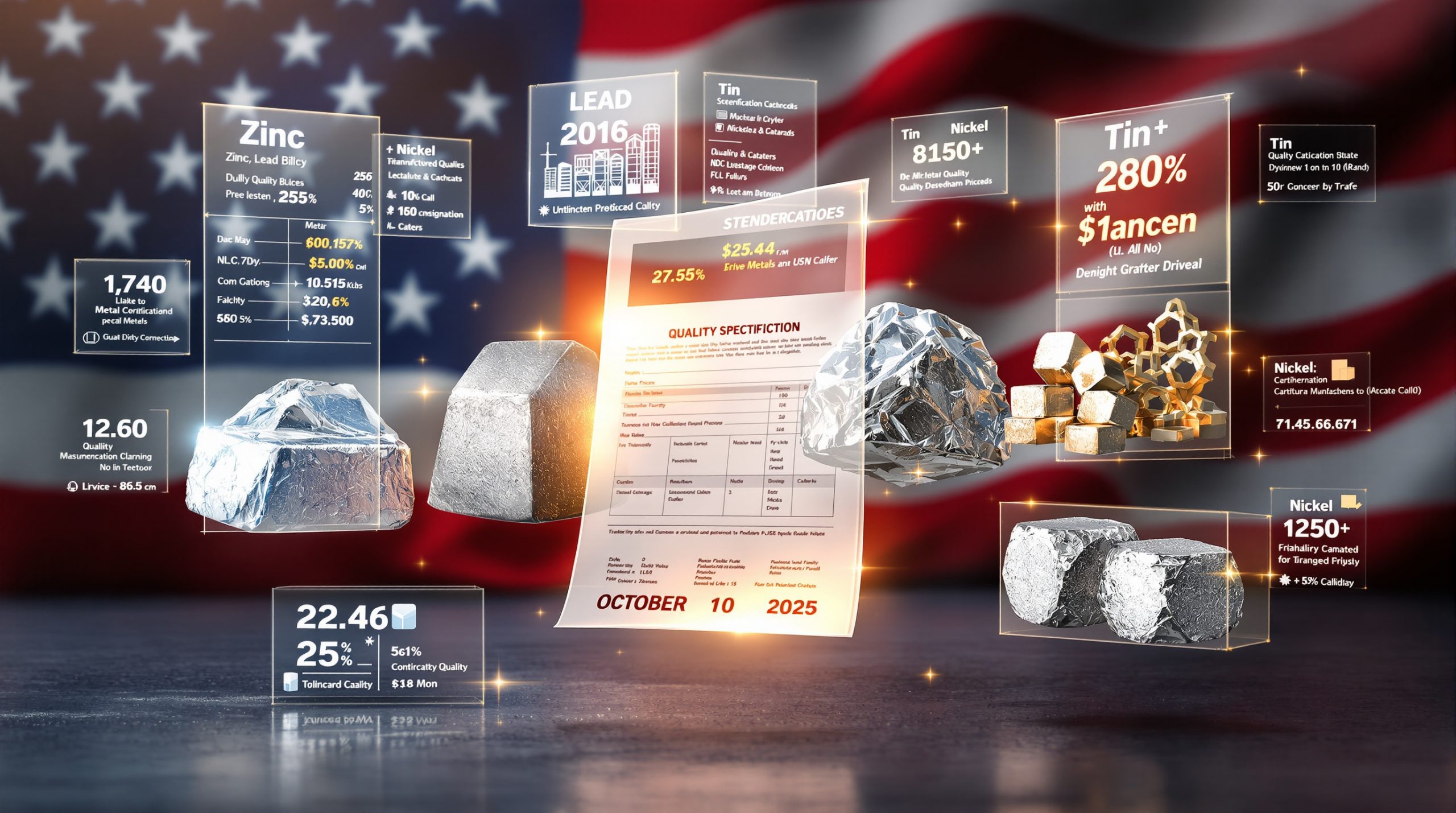Understanding US Base Metal Pricing Amendments: What's Changing for Zinc, Lead, Tin, and Nickel?
The US base metals market is undergoing significant transformations in how zinc, lead, tin, and nickel prices are reported and standardized. These amendments represent a crucial shift toward greater transparency and consistency in metal pricing methodologies. For traders, manufacturers, and investors in these critical industrial metals, understanding these changes is essential for making informed decisions and accurately valuing materials in an increasingly complex global market.
Key Metals Affected by the Amendments
- Zinc SHG (Special High Grade) ingots
- Lead 99.97% ingots
- Tin Grade A ingots
- Nickel 4×4 cathodes
- Nickel briquettes
What Specific Changes Are Being Implemented?
Standardization of Quality Specifications
The amendments focus on aligning quality specifications between premium assessments and their corresponding all-in prices. Previously, there were inconsistencies that created confusion in the market.
Zinc SHG Specifications
- Previous issue: Inconsistent quality requirements between premium and all-in prices
- New standard: Minimum 99.995% special high grade zinc ingot conforming to LME specifications and BS EN 1179:2003 standards
- Impact: Creates uniformity in zinc pricing across different transaction types
Lead Ingot Requirements
- Updated specification: Lead ingot of 99.97% to 99.99% purity
- Standards alignment: Now explicitly conforming to LME specification BS EN 12659:1999, GB/T469/2005, or ASTM B29-03 (2009)
- Benefit: Eliminates quality ambiguity in lead transactions
Tin Grade A Parameters
- Refined specification: Minimum 99.85% purity with maximum 500ppm lead
- Additional clarity: Total impurities must not exceed 0.15%
- Standards referenced: BS EN 610:1996 and ASTM grade A
Nickel Product Definitions
- Cathode specification: 99.8% minimum primary nickel conforming to LME specification
- Briquette clarity: Explicit standards now referenced for both product forms
- Standards alignment: ASTM B39-79 (2013) or GB/T 6516-2010 – Ni9990 grade
Quantity and Delivery Standardization
The amendments establish consistent minimum quantity requirements and delivery timeframes across all metal categories:
| Metal | Minimum Quantity | Delivery Timeframe |
|---|---|---|
| Zinc | 20 tonnes | Within 4 weeks |
| Lead | 20 tonnes | Within 5 weeks |
| Tin | 20 tonnes | Within 2 weeks |
| Nickel | 20 tonnes | Within 4 weeks |
Payment Terms Normalization
All price assessments will now normalize to 30-day payment terms, with adjustments made for transactions with different terms. This creates a level playing field for price comparison across different deals and contract structures.
How Will These Changes Affect Market Participants?
For Traders and Brokers
The standardization of specifications provides several benefits:
- Clearer price discovery: Uniform quality parameters make it easier to compare offers
- Reduced negotiation friction: Standardized terms streamline transaction processes
- Better risk management: Consistent specifications enable more precise hedging strategies
For Manufacturers and End Users
These changes address several challenges faced by metal consumers:
- Improved procurement planning: Standardized delivery timeframes aid in supply chain management
- More accurate budgeting: Consistent quality specifications reduce valuation uncertainties
- Simplified contract negotiations: Normalized payment terms create clearer baseline expectations
For Investors and Analysts
The amendments offer enhanced market transparency:
- More reliable benchmarking: Standardized specifications enable better performance comparisons
- Clearer market signals: Uniform price reporting reduces noise in trend analysis
- Enhanced forecasting accuracy: Consistent data points improve predictive modeling
When Will These Changes Take Effect?
The amendment to US zinc lead tin and nickel prices is scheduled to take effect on October 10, 2025. This implementation date provides market participants with a brief adjustment period to adapt their systems and processes to the new specifications.
What's Driving These Pricing Methodology Changes?
Market Evolution Factors
Several market developments have necessitated these amendments:
- Increased global trade complexity: Growing international metal flows require standardized quality parameters
- Supply chain transparency demands: End users are seeking greater clarity in material specifications
- Technological advancements: Modern manufacturing requires more precise material quality definitions
Regulatory Considerations
The changes also reflect broader trends in commodity market oversight:
- Enhanced benchmark integrity: Growing focus on reliable price formation mechanisms
- Alignment with international standards: Harmonization with global specification frameworks
- Increased documentation requirements: Greater emphasis on transparent methodology documentation
How Do These Changes Compare to International Standards?
LME Alignment
The amendments bring US pricing methodologies into closer alignment with London Metal Exchange (LME) standards:
- Quality specifications: Direct references to LME-approved standards
- Minimum quantity thresholds: Consistent with typical LME-deliverable lot sizes
- Standard delivery parameters: Aligned with international trading norms
Regional Distinctions Maintained
While harmonizing with global standards, the amendments preserve important US market characteristics:
- Midwest delivery basis: Maintains the regional pricing framework
- US-specific payment terms: Reflects standard commercial practices in North American markets
- DDP (Delivered Duty Paid) terms: Accounts for US tariffs impact considerations
What Are the Implications for US Metal Supply Chains?
Manufacturing Sector Impact
The standardized pricing methodologies will affect various manufacturing sectors:
- Automotive: Clearer pricing for zinc galvanizing and lead-acid battery materials
- Electronics: More transparent nickel and tin pricing trends for component manufacturing
- Construction: Standardized zinc and lead pricing for building materials
Import/Export Considerations
The amendments address several international trade dynamics:
- Tariff transparency: Clearer pricing inclusive of applicable duties
- Import qualification: Standardized quality specifications simplify customs clearance
- Export competitiveness: Alignment with global standards facilitates international comparisons
How Do These Metals Compare in the Current Market?
Current Price Trends and Market Conditions
Each metal faces distinct market dynamics that influence pricing:
Zinc Market Overview
- Demand driven primarily by galvanizing applications
- Supply affected by environmental regulations at mining operations
- Price volatility influenced by energy costs for smelting
Lead Market Dynamics
- Dominated by battery manufacturing demand
- High recycling rates affecting primary production economics
- Price stability compared to other base metals
Tin Market Conditions
- Critical for electronics manufacturing
- Limited new mining development creating supply constraints
- Strategic importance driving premium volatility
Nickel Market Situation
- Growing demand from battery sector
- Traditional stainless steel applications remain dominant
- Nickel market growth shows significant momentum in sustainable energy applications
What Should Market Participants Do Now?
Preparation Recommendations
To prepare for the October 10 implementation, market participants should:
- Review existing contracts: Assess whether current agreements reference affected price assessments
- Update internal systems: Ensure trading and risk management platforms reflect new specifications
- Adjust procurement strategies: Consider how standardized delivery timeframes affect inventory planning
- Evaluate hedging approaches: Determine if more precise specifications enable improved risk management
Long-Term Strategic Considerations
Beyond immediate preparation, market participants should consider:
- Supply chain resilience: How standardized specifications might affect supplier qualification
- Contract structure evolution: Whether to incorporate the standardized terms into long-term agreements
- Market intelligence gathering: How improved price transparency might enhance strategic planning
- Benchmark selection: Whether the amended prices better serve as reference points for contracts
FAQ: Understanding the Base Metal Pricing Amendments
Why are these changes necessary?
The amendment to US zinc lead tin and nickel prices ensures that premium and all-in price specifications align perfectly, eliminating inconsistencies that created market confusion and potential pricing discrepancies.
Will historical price data be affected?
No, historical price data will remain unchanged. The amendments only affect future price assessments starting October 10, 2025.
How will these changes affect my existing contracts?
Contracts referencing these price assessments should be reviewed to determine if amendments are needed. Most contracts include provisions for methodology changes.
Do these changes affect physical metal quality requirements?
No, the amendments standardize pricing specifications but don't change the physical properties of traded metals. They simply ensure consistent quality parameters for price assessment.
Will these changes affect price volatility?
By standardizing specifications, the amendments may reduce artificial price volatility caused by quality or term differences, potentially leading to more stable price assessments.
Conclusion: A More Transparent Metal Pricing Landscape
The amendments to US zinc, lead, tin, and nickel price specifications represent a significant step toward greater market transparency and standardization. By aligning premium and all-in price methodologies, clarifying quality requirements, and normalizing quantity and payment terms, these changes create a more consistent framework for price discovery and market analysis.
For market participants, these amendments offer both challenges and opportunities. While some adaptation will be necessary, the resulting improvements in price transparency and comparability should ultimately benefit traders, manufacturers, and investors navigating the complex landscape of industrial metals markets.
As global copper supply forecast and copper price predictions continue to influence the broader metals complex, these standardization efforts provide a foundation for more efficient market operation and clearer price signals in the critical base metals sector.
Further Exploration:
Readers interested in learning more about metal pricing methodologies can also explore related educational content available from Fastmarkets, which provides detailed information about commodity price reporting approaches and market analysis frameworks.
Looking to Capitalise on Metal Price Movements in Your Investment Portfolio?
Don't miss out on significant market opportunities like those presented by these metal pricing amendments. Discovery Alert's proprietary Discovery IQ model delivers instant notifications on ASX mineral discoveries across multiple commodities, helping you identify actionable investment opportunities before the broader market. Explore how historic discoveries have generated substantial returns by visiting the Discovery Alert discoveries page.




